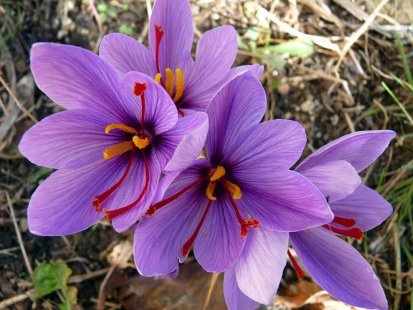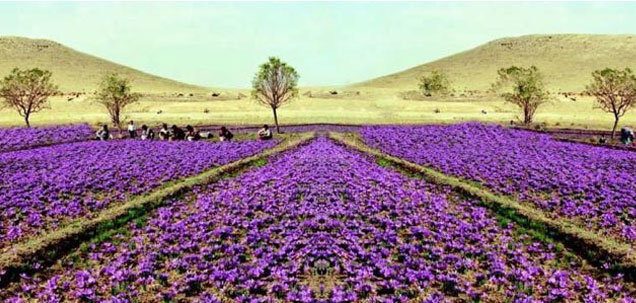
Saffron is a subtropical plant and grows well in places with mild winters and hot and dry summers. Saffron's resistance to cold is high, however since its growth period coincides with autumn, winter and early spring, it naturally needs a suitable and mild climate.
Soil suitable for growing saffron
In this article, we will provide you inforamation about saffron planting and weather conditions, etc.
Saffron Planting
Rainfall or irrigation is harmful to the plant during dormancy or rest (summer) so its cultivation is not common in Gilan and Mazandaran regions and warm areas of the south of the country Sunny and treeless lands that are not exposed to cold winds are also suitable for saffron growth.
However, in some villages of Birjand and Qaen, it is planted under the shade of barberry bushes and almond trees which are less irrigated in summer.
The maximum temperature of this plant is between 40 and 35 °C and at altitudes between 1300 and 2300 meters above sea level has shown good performance.
Suitable soil for growing saffron
Since saffron onion stays in the ground for a relatively long time (5-7 years), the soil should be light or a combination of sand and clay so that the onion can in addition to providing food, also withstand special regional conditions.
Therefore, in order to grow suitable and properly plants and produce high quality and desirable crops, fertile and drained lands without trees with soil(loamy, lemony, clay and sandy) and calcareous with pH between 8-7 should be prefered to salty, poor , wet and acidic lands. Saffron does not produce good crops in lands that do not have rubble or weeds or rotted organic matter.
Earth preparation
In the preparation of the land for the planting of saffron, it is necessary to pay special attention, first, at the appropriate opportunities in autumn or winter, the land is deeply plowed if the conditions are not suitable or the access to the tractor is not possible, plowing can be done at the end of spring or early July. To prepare the land in the traditional way, in early spring, after the spring rains stop, the land is plowed with Iranian plows. After 10-15 days, the land is plowed again.
and if the land is in the direction of the clods, they open the plow and crush the clods by using trowels .After two or three weeks, they plow the land twice in perpendicular directions, before the third plowing, For every 100 square meters of land, rotten animal manure is spread 5-10 times .
Farmers are well aware that frequent plowing, regardless of providing a suitable substrate for cultivating, they make the land somewhat clear of weeds.
In this method, the ground is plotted and the length and width of the plots are determined by the slope of the land and the strength of the water. Usually, the width and length of the plots are between 10*4 and 100*100 meters. in mechanized agriculture, saffron is plowed deep in the autumn of the year before cultivation .In spring, after the end of spring rains, the soil is cleared of weeds by doing medium plowing while breaking the ridge.
in August or September after spreading 40-80 tons of animal manure and 200 kg of ammonium phosphate the land is prepared for cultivation.(Of course, nutritionists recommend that about 250 kg of potassium sulfate be mixed with soil at this stage)

Selection of onions and saffron cultivation time
The construction of new saffron farms is only possible and common by its onions. Therefore, preparing and selecting high quality onions for planting is important in creating and expanding cultivation. Saffron onions can be transferred from the soil to another warehouse or farm, due to the soot of sleeping or resting of onions which lasts from the end of May to the end of August, it is possible to take out of the onions in this period. It is better to plant the onions after getting them out of the ground so that the onions are settled in the new land while resting. It is advisable to avoid taking out the onions in late August because at this time some onions may be ready for rooting and germination, It is better to have a shorter distance between removing the onions and planting .
However, saffron onions can be stored for several months in a cool, dry place at a height of 20-30 cm, but this prevents the physiological development of flowers and greatly reduces the yield of the first year of cultivation.
Saffron onion can be cultivated from autumn (early June to mid-October, but it is better to avoid planting onions in late July and early August because at this time the air and ground is very hot and it is feared that the moisture of the onion during the movement will be lost and damaged. According to research conducted by Khorasan Industrial Research Center,the best time for cultivation is June.
Compatible soil for saffron cultivation
The soil in which we want to plant the onions of saffron must be light and a combination of different salts in it.
Because saffron onion should be in that soil for 5 to 7 years and live.
Suitable soil
The soil that is a mixture of sand and clay has good nutrients and saffron onion grows well in it
Saffron can be resistant to climate change and is very suitable for saffron growth.
If you want to have a good crop, use fertile and drained land and do not use poor and salty land.
The earth must be without trees and mountain canopies.
The soil should be a mixture of clay, lemony, sand and loamy.
The earth must be limestone and the ph should be between 7 and 98.
The earth should be moist, salty and acidic and without nutrient.
Collect weeds before cultivating and collect rubble from the ground.
There should be no organic matter that is not decomposed in the soil.
Preparing the land for saffron cultivation
It is done in two ways:
1- The traditional planting method is with shovels.
2-Cultivation is mechanized.
Time in both methods is one of the most important factors
Many farmers prepare and plow the land in autumn or winter,
But if the conditions were not suitable or access to tractor and other equipment was not possible, This can be done at the end of spring or the first of July.
Mechanized cultivation:
In mechanized cultivationon, they have been working in mechanized cultivation to prepare the land since the autumn of last year.
First they flatten the land and plow very deep.
Then, in the spring after the rain is over, they start plowing operations with the cellulose to eliminate the weeds.
And in August and September, the land is prepared for cultivation
What is Farrowing the ground
This means spreading 40 to 80 tons of animal manure with 200 kilos of avminium phosphate in the ground so that the earth is fully prepared for cultivation.






User comments